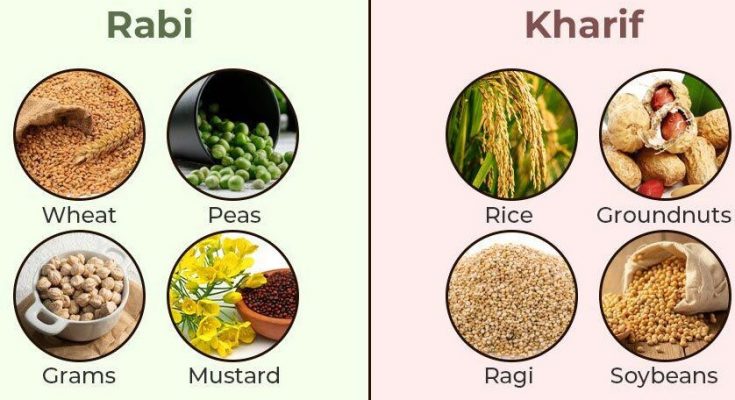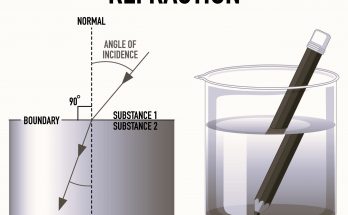The agricultural cycles in many regions, particularly in South Asia, are divided into two main seasons- Rabi and Kharif. This division is based on the seasonal variations that significantly affect farming activities, including the sowing, growing, and harvesting of crops. Rabi crops are typically sown in the winter and harvested in the spring, while Kharif crops are planted with the onset of the monsoon and harvested in the autumn. This distinction is crucial for understanding the agricultural patterns, water requirements, and climatic dependencies of different crops. The following analysis will detail the specific differences between Rabi and Kharif crops, focusing on aspects such as sowing and harvesting times, climatic needs, and typical crop examples.
Table of Contents
10 Differences between Rabi and Kharif crops in tabular Format
| Criterion | Kharif Crops | Rabi Crops | |
|---|---|---|---|
| 1. | Sowing Season | Early-May to July, with the onset of monsoon. | Around mid-November, after the monsoon rains. |
| 2. | Harvesting Season | September to October. | March to April of the following year. |
| 3. | Climatic Requirement | Requires hot weather and significant amounts of water. | Begin with warm conditions for seed germination, followed by cooler weather for growth. |
| 4. | Rainfall Dependency | Highly dependent on the monsoon rains. | Generally not affected by rainfall, but unexpected winter rain can cause damage. |
| 5. | Typical Examples | Rice, Cotton, Bajra, Maize, Jowar, Pulses. | Wheat, Barley, Oats, Pulses, Mustard, Linseed. |
| 6. | Also Known As | Monsoon or Autumn Crops. | Winter or Spring Crops. |
| 7. | Water Requirement | High, primarily fulfilled by monsoon rains. | Moderate, mostly met through irrigation. |
| 8. | Etymology | “Kharif” translates to “autumn season” in Arabic. | “Rabi” translates to “spring season” in Arabic. |
| 9. | Extrinsic Factors | Affected by environmental factors, climate change, and socio-economic conditions. | Similarly influenced by external factors like climate change and socio-economic conditions. |
| 10. | Intrinsic Factors | Include genetic variations, resistance to pests and diseases, and effects of agricultural inputs. | Also involve genetic factors, disease resistance, and responses to agricultural practices. |
Difference between Rabi and Kharif crops – Detailed Explanation
Difference between Rabi and Kharif crops in terms of Sowing Season-
- Kharif Crops- These crops are planted at the onset of the monsoon season, typically from early May to July. This timing aligns with the arrival of the south-west monsoon in India, starting in states like Kerala and Tamil Nadu before advancing northward. The sowing time adjusts accordingly, with earlier planting in the south.
- Rabi Crops- Rabi crops are sown in the cooler months, around mid-November, after the monsoon rains have ceased. This period allows the crops to establish themselves before the colder winter months set in, providing an optimal growth environment.
Difference between Rabi and Kharif crops in terms of Harvesting Season-
- Kharif Crops- Harvest occurs post-monsoon, from September to October. The exact timing can vary based on regional climate variations and the specific crop’s growth cycle.
- Rabi Crops- These crops are harvested in the spring, from March to April of the following year, coinciding with the end of the cooler winter period and the onset of warmer temperatures.
Difference between Rabi and Kharif crops in terms of Climatic Requirement-
- Kharif Crops- They thrive in hot, humid conditions prevalent during the monsoon season and require ample water, which is predominantly supplied by monsoon rains.
- Rabi Crops- The initial warm conditions are crucial for seed germination, followed by cooler weather which is ideal for the growth phase of these crops. They are less dependent on rainfall and more on cooler temperatures.
Difference between Rabi and Kharif crops in terms of Rainfall Dependency-
- Kharif Crops- Their success is closely tied to the monsoon rains. Adequate and timely rainfall is crucial for these crops, while both excessive and insufficient rainfall can adversely affect the yield.
- Rabi Crops- They are largely unaffected by rainfall, relying instead on irrigation to meet their water needs. However, unexpected rain during winter can damage these crops.
Difference between Rabi and Kharif crops in terms of Typical Examples-
- Kharif Crops- Include water-intensive crops like Rice and Cotton, and other crops such as Bajra, Maize, Jowar, and Pulses that are suited to the monsoon climate.
- Rabi Crops- Comprise crops like Wheat and Barley, along with Oats, Pulses, Mustard, and Linseed, which are suited to cooler growing conditions.
Difference between Rabi and Kharif crops in terms of Water Requirement-
- Kharif Crops- These crops require large quantities of water, making them highly reliant on monsoon rains.
- Rabi Crops- Need consistent irrigation but generally have a lower water requirement compared to Kharif crops, due to the cooler climate reducing evaporation rates.
Difference between Rabi and Kharif crops in terms of Etymology-
- Kharif and Rabi terms are derived from Arabic, corresponding to the “autumn” and “spring” seasons, respectively. These terms are a nod to the historical agricultural practices and seasons in the Indian subcontinent.
Difference between Rabi and Kharif crops in terms of Extrinsic Factors-
- Both crop types are influenced by external factors such as environmental conditions, climate change, and socio-economic factors. For Kharif crops, the timing and quantity of monsoon rains are crucial, while Rabi crops are more affected by the availability of irrigation and cooler temperatures.
Difference between Rabi and Kharif crops in terms of Intrinsic Factors-
- Genetic variations, pest and disease resistance, and the impact of agricultural inputs like pesticides and insecticides are critical for both Kharif and Rabi crops. However, the specific challenges and requirements may vary between the two, with Kharif crops being more prone to water-related diseases and pests due to the humid conditions, while Rabi crops might be more susceptible to cold-related stresses.
Also Check – How lower Kharif crop production could affect the Indian economy
Frequently asked questions on Difference between Rabi and Kharif crops
What are Rabi crops, and when are they sown and harvested?
- Answer- Rabi crops are those grown during the cooler winter months, typically shown around mid-November and harvested in the spring, from March to April. They include crops like wheat, barley, oats, and pulses, which require a warm climate for seed germination followed by cooler weather for growth.
Describe Kharif crops and their cultivation period.
- Answer- Kharif crops, also known as monsoon crops, are cultivated with the onset of the rainy season, usually from early May to July, and harvested in the autumn, around September to October. These crops, including rice, maize, cotton, and pulses, thrive in hot and wet conditions provided by the monsoon rains.
Explain the climatic requirements for Rabi and Kharif crops.
- Answer- Kharif crops require hot weather and a significant amount of water, largely dependent on monsoon rains, whereas Rabi crops need a warm climate initially for seed germination, followed by cooler weather for optimal growth. Rabi crops are less dependent on rainfall and often rely on irrigation.
How do the water requirements of Rabi and Kharif crops differ?
- Answer- Kharif crops require abundant water for growth, making them heavily reliant on the monsoon rains, while Rabi crops have comparatively lower water requirements and are often grown with the help of irrigation, as they are cultivated in cooler, less evaporative conditions.
What factors influence the growth of Rabi and Kharif crops?
- Answer- Both crop types are affected by intrinsic factors like genetic variations, resistance to diseases, and pests, and extrinsic factors such as environmental conditions, climate change, and socio-economic factors. However, Kharif crops are particularly sensitive to the timing and quantity of rainfall, whereas Rabi crops are more influenced by temperature and irrigation practices.
List some examples of Rabi and Kharif crops and explain why they are categorised as such.
- Answer- Examples of Kharif crops include rice, maize, and cotton, which are categorised based on their need for warm, wet conditions typical of the monsoon season. Rabi crops, like wheat, barley, and oats, are classified due to their preference for cooler growing conditions and lesser dependence on rainfall.
Discuss the significance of understanding the differences between Rabi and Kharif crops in agricultural planning.
- Answer- Understanding these differences is crucial for agricultural planning as it helps in deciding the planting schedules, managing irrigation requirements, and implementing appropriate crop rotation practices. It also aids in predicting crop yields, which is vital for food supply planning and managing market prices.

